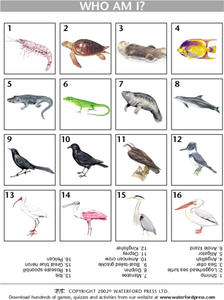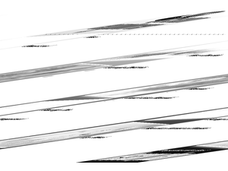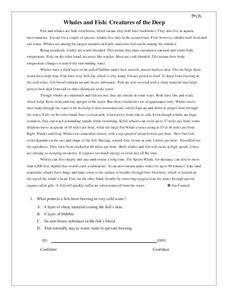Curated OER
AP: Chapter 10: Photosynthesis
AP biologists or college-level botanists consider in-depth details of the photosynthetic process. They examine the structures in a leaf and the roles that they play. They label neat and colorful diagrams of photosystems and electron...
Curated OER
Raven Chapter 12 Guided Notes: Sexual Reproduction & Meiosis
Young biologists define reproduction vocabulary terms, answer critical-thinking questions, label a diagram of the human life cycle, and complete a chart comparing mitosis to meiosis. This is a well-balanced instructional activity. Even...
Field Museum
The Case of Darwin's Finches
One of the most striking pieces of evidence for Darwin's Evolution of Species was his observations of finches and how their beaks differed from island to island, depending on their primary food sources. So what would happen to the theory...
Curated OER
Persuasive Writing-"Those Whales"
Use an article about an Orca killing a trainer to help writers complete a persuasive essay. The article, other templates, and models are attached. Scholars divide up into groups of three where each person takes a different role,...
Ask a Biologist
Desert Tortoise
The desert tortoise is a protected species, and it's population in some areas, such as Joshua Tree State Park in California, has been rapidly declining over the years. Invite your young biologists to study the Desert Tortoise with this...
Curated OER
Circle of Life
Here is a well-designed science lesson that shows learners that everything that organisms do in ecosystems, including running, breathing, burrowing, growing, requires energy. After a thorough discussion of their own eating and drinking...
Curated OER
Who Am I?
Young biologists can see pictures of animals, fish, sea life, plants, and more. They match up the name of the animals that appear at the bottom of the worksheet with the actual animal. Very nice worksheet!
Curated OER
Who Am I?
Young biologists can see a variety of animals, amphibians, mammals, insects and clearly identify them. They match up the animals' names with the picture. The pictures are clear and colorful! A very nice worksheet for early elementary...
Curated OER
The Plant
Here is a good, basic, and solid lesson plan on the parts of a plant. Young biologists learn about the parts of a plant, and what each one does. Additionally, learners look at the parts of plants that are used by people and determine...
Desert Discovery
Saguaro Parts
Young biologists identify the basic structures of a saguaro cactus. They study the functions of each of the structures, and label them on a picture of a saguaro cactus embedded in the plan. This simple, and easy-to-implement lesson would...
Desert Discoveries
What's the Buzz on Native Bees?
Young biologists describe the different types of bees that are native to the Sonoran Desert. They look at the nesting and feeding requirements of the insects, and study how they are able to pollinate many plants found in the environment....
Curated OER
Anchialine Cave Species
Ever heard of a stygofauna or a stygobite? How about an anchialine cave? Set your young biologists on a quest to find information about organisms that live in and have adapted to life in caves located near the water. Class members then...
K12 Reader
Competing for Resources
Young biologists examine the concept of scarce resources with a reading comprehension passage. After finishing the paragraphs, learners turn to the questions to demonstrate what they have learned about what is beneficial and what is...
Curated OER
Fun with Fictitious Animals
How can one differentiate between a dweezlebub and nessie? Use this fictitious creature dichotomous key to find out! Biologists of all ages will enjoy this creative way to learn about classification, including a chance to draw the...
Have Fun Teaching
Growing Seeds (9)
A seed, water, and sunlight. A seed, water, but no sunlight. A seed, sunlight, but no water. Young biologists are ask to infer what will happen to seeds given five different growing conditions.
Curated OER
Parts of a Snail
Here is a simple, yet well-designed worksheet on the parts of a snail for your young biologists. Learners label the five parts of a snail using words that appear on the worksheet. Then, they circle the words on the bottom of the...
Curated OER
Do Some Research: Bones in the Body
Where are the smallest bones in your body located? Using the Internet and/or library, young biologists locate, illustrate, and write an explanation of where these tiny bones can be found.
Curated OER
Animal Feeding Strategies
How do different animals eat? This cross-curricular worksheet has biologists describing types of eaters and giving examples. Eight short-answer questions prompt learners to identify a carnivore, herbivore, omnivore, insectivore,...
Curated OER
Comparing the Amoeba to Paramecium
This laboratory activity is valuable practice in comparing features of different organisms. You could use it to introduce junior biologists to protozoans. The materials and procudures for the learners are simple, and analysis questions...
Curated OER
The Case of Regulation in Cells
After your biologists have learned about transcription, translation, and gene regulation, they work in a small group to create a poster of a system that serves as an analogy of the gene regulation process. They share their creations with...
World Wildlife Federation
Food Chains and Food Webs
As part of a study of food chains and food webs, class members complete a series of worksheets that trace a marine chain from producers to consumers or decomposers. After studying a food chain example, young marine biologists make up...
Curated OER
Whales and Fish: Creatures of the Deep
Practice comparing and contrasting details in informational text with a reading passage about whales. It explains the ways that fish and whales are similar, as well as the ways they are different, and specific characteristics of various...
EngageNY
Introducing the Struggle for Survival in the Introduction of World without Fish
No fish? Catch a word. Scholars read World without Fish and record unfamiliar vocabulary in their word catchers. They discuss word meanings as well as root words. They answer text-dependent questions before discussing the importance of...
Scholastic
A House for Hermit Crab
Engage young marine biologists in a reading of Eric Carle's A House for Hermit Crab with a fun hands-on activity. Given a set of clipart images of the different aquatic animals that appear in the book, children identify each one during a...
Other popular searches
- Famous Biologists
- Marine Biologists
- Famous Cell Biologists
- Wildlife Biologist
- Early Biologist
- International Biologist
- Biologists Past and Present
- Research a Biologist
- Biologists Alive
- Native American Biologist
- Cell Biologists
- Biologist Trading Cards

























